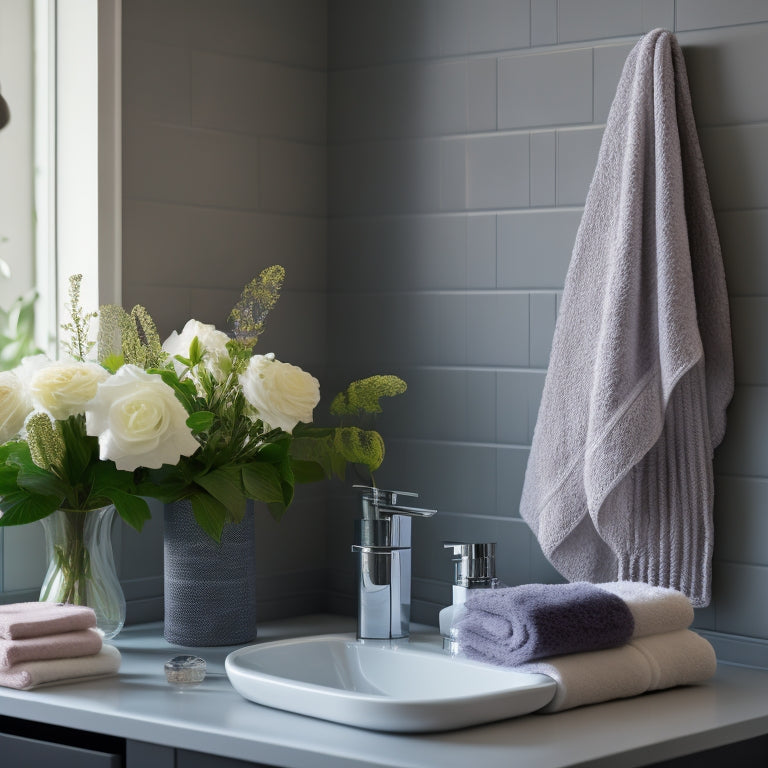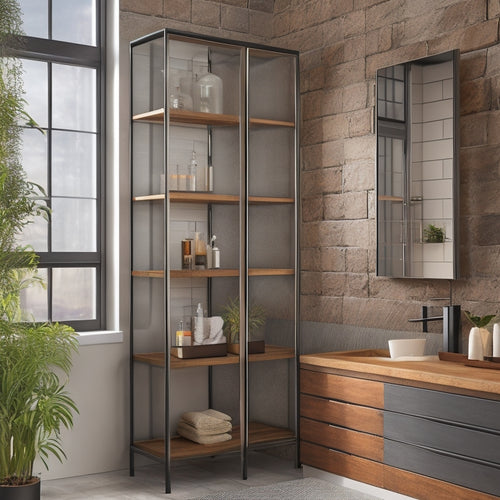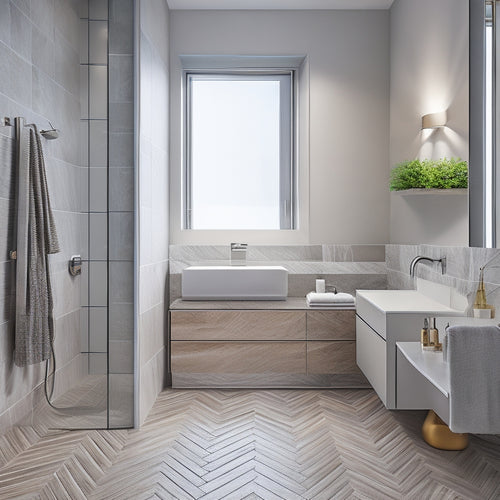
5 Best Bathroom Shelf Liner Installation Techniques
Share
To achieve a professional-looking bathroom shelf liner installation, you'll want to master five essential techniques. Start by measuring your shelf accurately, considering obstructions and material thickness. Next, choose between adhesive and non-adhesive liners based on your needs. Thoroughly clean and prepare the shelf surface, then apply the liner in small sections, removing air bubbles as you go. Troubleshoot common issues by identifying root causes and making adjustments. By following these best practices, you'll be on your way to a successful installation that withstands the humid bathroom environment. Now, learn how to refine your skills and ensure a flawless finish.
Key Takeaways
• Measure shelf dimensions accurately, considering obstructions and material thickness, to ensure a perfect fit.
• Choose the right liner type (adhesive or non-adhesive) based on personal needs and preferences for a successful installation.
• Prepare the shelf surface by thoroughly cleaning and sanding to ensure a strong bond between the liner and shelf.
• Apply the liner correctly by peeling off the backing, aligning it with the shelf edge, and removing air bubbles with a credit card or squeegee.
• Troubleshoot common issues by cutting out damaged areas, leveling the shelf, and gently heating warped areas to relax the liner.
Measuring for a Perfect Fit
Measure the width of your bathroom shelf carefully, taking into account any obstructions, such as plumbing or electrical outlets, to guarantee a perfect fit for your liner. You don't want to end up with a liner that's too small or too large for your shelf. Take precise custom measurements to secure a snug fit. Record the shelf dimensions, including the length, width, and any cutouts or notches that need to be accommodated.
Next, consider the material thickness and texture of your liner. Will it be a thin, flexible liner or a thicker, more rigid one? This will impact the fit and how you'll need to trim the liner to fit around obstructions. Take your time and double-check your measurements to avoid errors. It's better to be safe than sorry when it comes to achieving a perfect fit.
With accurate custom measurements, you'll be able to select the right liner for your bathroom shelf and ensure a successful installation.
Adhesive Vs Non-Adhesive Liners
Choosing the right type of liner for your bathroom shelf depends on your personal preference for ease of installation and the level of permanence you desire, with adhesive liners offering a secure, long-term hold and non-adhesive liners providing flexibility and ease of removal.
Adhesive liners are ideal for you if you want a secure fit that can withstand moisture and humidity. They're perfect for bathroom shelves that are exposed to water or high humidity. These liners are more durable and less prone to peeling or lifting, ensuring your shelf liner stays in place for a long time. However, they can be more challenging to remove if you need to replace them.
Non-adhesive liners, on the other hand, are a great option if you want ease of installation and removal. They're perfect for renters or those who like to switch up their bathroom decor frequently. These liners are easier to install and remove, making maintenance a breeze. However, they may not be as durable as adhesive liners and may require more frequent replacement.
Consider your priorities and choose the liner that best fits your needs.
Preparing the Shelf Surface
Before applying your new liner, thoroughly clean the shelf surface to remove any dirt, grime, or old adhesive residue that might interfere with the liner's adhesion. You'll want to make sure the surface is spotless, as any contaminants can compromise the liner's sticking power. Use a gentle cleaning product and a soft cloth to wipe down the shelf, paying special attention to any areas with visible stains or buildup.
Next, use a fine-grit sandpaper to lightly sand the surface. This will help create a rough texture for the liner to adhere to, ensuring a strong bond. Be sure to wipe away any dust or debris from the sanding process before proceeding.
Proper shelf cleaning and surface sanding are vital steps in preparing your shelf for the liner. By taking the time to do it right, you'll set yourself up for a successful installation that will last for years to come.
Applying the Liner Correctly
With your shelf surface properly prepared, you're ready to apply the liner, starting by peeling the backing off the liner's adhesive side. Hold the liner with the adhesive side facing down, and carefully align it with the shelf edge. Guarantee a smooth, wrinkle-free application by using a credit card or squeegee to remove any air bubbles, working from the center outwards.
To avoid liner creases, apply the liner in small sections, smoothing each area before moving on to the next. Pay close attention to edge alignment, making sure the liner is flush with the shelf edge. Use the following guidelines to achieve a professional-looking installation:
| Liner Alignment | Tips |
|---|---|
| Edge alignment | Align the liner with the shelf edge, ensuring a seamless joint |
| Liner creases | Apply the liner in small sections, smoothing each area before moving on |
| Air bubbles | Use a credit card or squeegee to remove air bubbles, working from the center outwards |
Troubleshooting Common Issues
Now that you've successfully applied the liner, you'll want to be prepared to tackle any issues that may arise during the installation process. One common problem you may encounter is liner damage, which can occur if the liner is stretched too tightly or if it's exposed to excessive moisture. To fix damaged liner, simply cut out the affected area and replace it with a new piece, guaranteeing a seamless joint.
Another issue you might face is shelf warp, which can happen if the shelf isn't properly aligned or if the liner is applied unevenly. To prevent shelf warp, double-check your measurements and ensure the shelf is level before applying the liner. If you do notice warping, gently heat the area with a hairdryer to relax the liner and reapply it smoothly.
When troubleshooting, it's crucial to identify the root cause of the issue to prevent it from happening again. Take your time, and don't hesitate to start over if necessary. Remember, a successful installation requires patience, attention to detail, and a willingness to adapt to unexpected challenges.
Frequently Asked Questions
Can I Use a Bathroom Shelf Liner in a Shower or Bathtub Area?
You can use a bathroom shelf liner in a shower or bathtub area if it has a waterproof coating, but make sure it's specifically designed for wet areas and consider a shower caddy for added support.
How Often Should I Replace My Bathroom Shelf Liner?
"An ounce of prevention is worth a pound of cure." You should replace your bathroom shelf liner every 6-12 months, depending on usage and Liner Durability, to maintain Shelf Maintenance and prevent water damage and mold growth.
Are Bathroom Shelf Liners Resistant to Mold and Mildew?
You'll be relieved to know that most bathroom shelf liners are designed to resist mold and mildew, thanks to advanced material science and humidity-fighting properties that combat moisture buildup, ensuring a cleaner, healthier space.
Can I Cut a Bathroom Shelf Liner to Fit an Irregularly Shaped Shelf?
"As you navigate the puzzle of your irregularly shaped shelf, remember: custom cutting is key. You'll need to take precise measuring to the next level, ensuring a seamless fit that's tailored to your unique space, like a glove fitting a hand."
Are Bathroom Shelf Liners Safe for Use With Heated Shelves?
It's important to make sure your bathroom shelf liner is heat-resistant to prevent heat damage and shelf warping; look for liners with high-temperature ratings or specific 'heat-resistant' labels to guarantee a safe and durable installation.
Conclusion
You've successfully installed your bathroom shelf liner, and now it's time to step back and admire your handiwork. Your shelves are now protected, organized, and easy to clean.
As you gaze at your newly lined shelves, imagine water droplets beading up and rolling off, soap scum wiping away with ease, and your bathroom exuding a revitalizing, clean scent.
With these installation techniques, your bathroom has transformed into a serene oasis, where every morning starts on a rejuvenating note.
Related Posts
-

Tall Industrial Bathroom Cabinet for Narrow Spaces
A tall industrial bathroom cabinet is your solution for narrow spaces, combining style with practicality. It reaches ...
-

Contemporary Slimline Storage for Modern Bathrooms
As you envision your modern bathroom, consider the innovative potential of contemporary slimline storage. By cleverly...
-

Contractor's Cost-Saving Tile Strategies and Designs
When tackling a tile project, I've learned that smart design decisions can lead to significant savings. By prioritizi...


